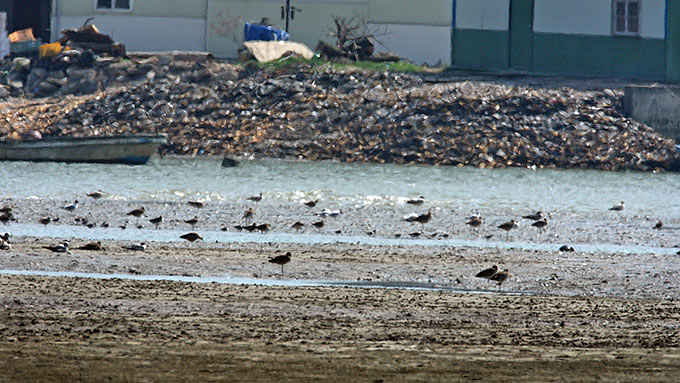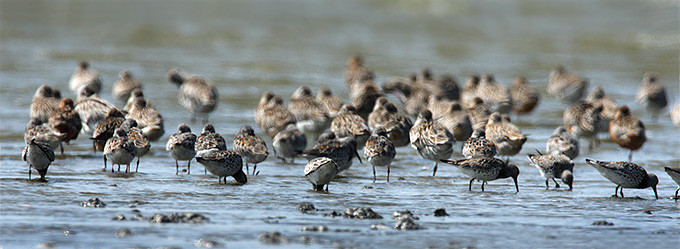This Update covers April 1st - April 30th 2008. It is in three parts:
The national Yeonhap News Agency reported on April 30th that there have now been 29 outbreaks of Highly Pathogenic Avian Influenza H5N1 (HPAI H5N1) confirmed so far this year, with five further potential outbreaks also undergoing detailed investigation. This is the third time in recent years that the nation has suffered outbreaks of H5N1 “Poultry Flu”, with earlier outbreaks in both 2003-2004 and 2006-2007. Despite the continuing and rapid spread of the disease in poultry (perhaps only to be expected considering the intense industrialization of “poultry production”), public reaction has remained largely muted. This is presumably in part due to an increasing familiarity with the disease through earlier outbreaks, and also this time due to official blame for the spread being directed more towards the allegedly illegal sale of already sickened poultry and poultry products, rather than on migratory birds (as in previous outbreaks).
Focus (away from Saemangeum at least: please see below) has therefore remained for much of April on the proposed Korean Grand Canal project, the first phase of which entails joining up the Han River in the north-west to the Nakdong River in the south-east. Later stages, as proposed, would then require the canalization (i.e. dredging and river widening) of 3,100 km of river on the peninsula, in order to create major shipping routes through rivers and estuaries that contain eight or more Important Bird Areas in South Korea alone (ten if the now reclaimed estuaries of the Mangyeung and Dongjin Rivers of Saemangeum are included). Recent opinion polls cited in leading media suggest that the majority of people are now opposed to the Grand Canal project. Despite this, the Korea Herald (April 29) reported that the government has stated that it will push ahead with the controversial project “if private firms make proposals.” According to the same article, “ ‘If private companies propose business plans (on the canal), we will review the opinions of experts and people broadly and go ahead with it,’ the (Land) ministry said in a report to the National Assembly….The ministry also plans to discuss the plan with the Assembly, provincial governments and other related institutions, it added. Analysts said that the ministry report could be seen as an official announcement that the government will not abandon the canal project despite mounting opposition.” (Korea Herald, April 29th). The newly elected government has been calling for a special session of the National Assembly in May, at which time it is expected that a Special Law to allow construction of the Canal will be debated (and likely passed). Such Special Laws have already been passed (in late 2007) to accelerate the reclamation of Saemangeum, and to promote development of the Coastal Zone. In response to the very obvious threats to biodiversity posed by this project, Birds Korea has been appealing for international letters of concern; promoting international email campaigns, in collaboration with a larger national organisation; and we have also posted a letter of concern on behalf of our membership. All will be passed on to the relevant authorities this spring.
As probably all of our members know, April 21st marks one of the saddest days in the conservation calendar, with this date in 2008 being the second anniversary of the closing of the 33-km long Saemangeum sea-wall. Claimed as an “environmentally-friendly” project by proponents, the 40,100 ha Saemangeum reclamation aims to convert what was formerly the most important shorebird site in the Yellow Sea into land and a huge (11,000 ha) freshwater reservoir, none with any clear end-use. With the project still pushed by development bodies, most of the tidal-flats of Saemangeum two years on now look bare and desert-like, or are covered in planted vegetation and garbage.
While Birds Korea (and all the very many others opposed to the reclamation) were unable to prevent the closure of the seawall in 2006, we determined that we would gather data to document the impact of this reclamation on populations of migratory shorebirds (in line with Ramsar Resolution 9.15 in 2005, which requested “the government of the Republic of Korea to advise the Secretary General of the current situation concerning the sea-wall construction and reclamation of the Saemangeum coastal wetlands, and the impact of the construction work to date on the internationally important migratory waterbird populations dependent upon these wetlands”). This decision led to the development of the Saemangeum Shorebird Monitoring Program (SSMP) in early 2006, a joint project of Birds Korea and the international Australasian Wader Studies Group (For our first formal posting of this idea, please see: Saemangeum Time to Act.). Initially proposed as a three-year research project, the SSMP has been designed to be scientifically rigid, open and inclusive.
While the Ramsar Secretariat still continues unsuccessfully to request government data on the impacts of the reclamation on waterbirds in line with Resolution 9.15 (most recently in late February 2008, at the 36th Ramsar Standing Committee meeting), the SSMP continues to gather and provide scientifically rigorous data and analysis to concerned organizations in Korea, and internationally, through websites, publication, national and international meetings, and through media (with for example broadcast on France’s Channel Three “Thalassa” in March 2008, and coverage in the national Hangyoreh Newspaper, in April 2008).

Thanks to the strength and success of the partnership with the AWSG; to the commitment and tremendous support of participants and supporters; and of course to funding from private donors and the David and Lucile Packard Foundation (many sincere thanks to all), the SSMP has again been underway throughout April this year, already allowing for valuable comparisons of shorebird numbers and habitat pre- and post Saemangeum seawall closure (see e.g.: Saemangeum Mainpage).
This April, repeat counts and habitat assessment of the Saemangeum reclamation area (and the adjacent Geum Estuary and Gomso Bay) have shown another significant drop in number of shorebirds at Saemangeum – with for example 69,411 counted during the mid-late April tide series in 2007, but only 46,018 counted there between April 18th and 20th 2008 (For more information on these mid-April counts: SSMP 2008 Second Count Cycle Summary). SSMP counts will continue in May, with most effort focused on the spring tide series between May 5th and 10th, and again between May 21st and 26th.

While the SSMP appears already to have demonstrated that shorebirds displaced by the loss of the Saemangeum estuarine system did not simply move to adjacent areas (as previously claimed would happen by project proponents), we have not yet demonstrated adequately that the birds did not simply move to other sites in South Korea. This is important to determine, as conservation of the populations of waterbird species at the national level is obligated by conventions such as Ramsar and the Convention on Biological Diversity, and is inherent in bilateral treaties such as the Republic of Korea-Australia Migratory Bird Agreement. Supported by the AWSG and other volunteers, Birds Korea will therefore be conducting a two-week count of west coast and south coast shorebird sites, between May 3rd and May 15th, covering Ganghwa Island, Yeongjeong, Song Do/Sorae and Shihwa, Teibu Do, Namyang and Asan Bays, Seosan (and the coast south from there), the SSMP count area, Hampyeong Bay, Muan, Aphae Island in Shinan Gun, Mokpo Urban wetland, Haenam coast, Suncheon Bay and the Nakdong Estuary in Busan – all sites that have been shown in previous surveys to support internationally important concentrations of shorebirds. We welcome your involvement and support!
As with the SSMP, count data from this Birds Korea National Shorebird Survey will be posted on our websites, and will be contained in reports being prepared in time for the Ramsar Convention conference to be held in Changwon City, between October 28th and November 4th.
Further Birds Korea work in May and June includes the preparation of a textbook on birds and wetlands for use by the Nakdong River Korea Wetlands Project and Changwon City; an English-language environmental education camp in the southeast in mid-June (volunteer teachers: please join us!); continuing work on the Yellow Sea shorebirds book (a process headed by top shorebird photographer and Birds Korea international member Mr. Jan van de Kam), and more public awareness work and education programs at the wonderful Mokpo Urban wetland, a site with enormous potential for developing management techniques, and environmental education programs.
Compiled by Tim Edelsten, and edited by Nial Moores
American Wigeon Anas americana V2
One male was photographed at Gyehwa-do, Saemangeum, on April 6th (SSMP).
Saker Falcon Falco cherrug V2/3
One seen at Eocheong island on April 21st (Nial Moores & Robin Newlin) is a first for the island, and apparently only approximately the 10th Korean record of this species.
Oriental plover Charadrius veredus V2
A flock of eight at Suncheon Bay on April 5th (Rich Lindie & Hayley Wood) is the highest national count of this species known to Birds Korea. On Marado Island, off Jeju, one was photographed and posted to the http://birdsinjeju.com website on April 6th, followed by a different individual , posted on April 12th, when there were also two or more photographed on Heuksan Island (Kim Seong-Jin).
Nordmann's Greenshank Tringa guttifer EN, P4
One photographed (apparently on Jeju Island), on April 6th by the Jeju Wild Animals Centre, is the first record of the year. At the Geum Estuary on April 16th, 11 or 12 were seen by members of the SSMP; on April 19th, five were photographed at Hwaseong in Gyeonggi province (Shim Kyu Sik).
Little Stint Calidris minuta V2
One was photographed on Heuksan Island on April 16th (Park Jong Gil).
Ruff Philomachus pugnax P5
Up to 20 seen at Hwaseong on April 26th, (Shim Kyu-Sik), is believed to be the highest national count to date of this species.
Gull-Billed Tern Gelochelidon nilotica V3 (So)
One at Yubu Island, Geum Estuary, photographed on April 6th (SSMP) is apparently only the fifth record for South Korea.
Caspian Tern Hydroprogne caspia V2/3 (So)
One was photographed at Gangneung, Gangwon province on April 16th (Park Ju Young). First recorded in 2001, and recorded annually since, this apparently becomes approximately the 8th record (involving 9 individuals).
Crested Murrelet Synthliboramphus wumizusume VU, V1
One on April 1st, seen in flight between Yeon and and Eocheong Islands (Nial Moores).
White-bellied Green Pigeon Treron Sieboldii V2 (So)
One photographed, presumably on Jeju island, and posted to the http://birdsinjeju.com website on April 20th is apparently the 12th record for the ROK.
Northern House Martin Delichon (urbicum) dasypus V2
Two seen at Eocheong Island on April 23rd, (and two again on April 26th) by members of the SSMP are probably the 13th and 14th records, since the first in 2003.
Himalayan Swiftlet Aerodramus brevirostris V2 (So)
At least two (and possibly up to six), seen on Eocheong island (Fred Van Gessel & Geoff Styles) on April 25th constitutes probably the 13th national record. This species has been recorded annually since the first in 2001.
Pine Bunting Emberiza leucocephalos. PV1 WV2
One male photographed on Eocheong Island from April 2nd-3rd (Nial Moores) appears to be of the fronto subspecies. Most checklists suggest the subspecies occurring in Korea should be nominate.
Black-headed Bunting V3 (So)
One male photographed on Weiyon Island, on April 27th (Lee Yu Man), is probably only the 9th record for Korea.
Finally, a gentle reminder to all of our members, past and present, living in Korea. Birds Korea depends entirely on the support of our members and volunteers. Donations and domestic membership fees are vital to us! Please renew your membership (annual membership fee is only 30.000 Korean won; and life-time membership only 150.000 Korean won at this time), and help us to help the birds!
Birds Korea, April 30th, 2008.



